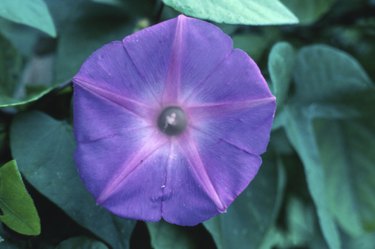
Morning glories are simply beautiful, with trumpet-shaped, different-colored flowers as well as heart-shaped leaves and a high tolerance for drought. Humans, hummingbirds and butterflies love most morning glory varieties, and these climbing beauties are not hard to transplant.
Morning Glory Types
Video of the Day
Morning glories are flowering vines, and unless they are growing in USDA hardiness zones 10 or 11, they will be annuals. They can self-seed, though, and sometimes do so aggressively. There are many morning glory varieties, including the 'Crimson Rambler,' which has deep pinkish-red flowers and does best in full sun.
Video of the Day
The 'Caprice' produces sky-blue blooms with lavender stars at their centers. This variety grows especially fast and can flourish up to 20 feet. The 'Flyer Saucer' morning glory has big sky-blue flowers with yellow centers and white streaks. It can do very well in sun and partial shade.
Birds, bees and butterflies love the 'Grandpa Ott' morning glory, with its 15-foot-long vines and abundant, deep-purple flowers. The two-toned, aptly named 'Carnevale di Venezia' (this name translates to "Carnival of Venice") is another beauty. Its white flowers are highlighted by variegated, different-colored stripes, and it can grow up to 10 feet long and 16 feet high.
Transplanting Morning Glories

These flowers are easy to grow, but transplanting established morning glories is not an easy task. These plants do not like to have their roots disturbed, so it is best to wait until they flower and produce seeds. These can then be collected and planted by a fence, as morning glories are excellent climbing plants for a trellis.
Morning glories have finicky roots, so it is best not to pull them out of the ground and attempt transplants. If you want to try transplanting morning glories from pots, buy ones that are sold in peat pots that can be planted into the soil. These biodegradable pots are used for annual and perennial plants, including morning glories.
To transplant morning glories from peat pots into your garden, try watering the plants thoroughly before attempting the move. Dig the holes first, making them slightly bigger than the peat pots and do not touch or rip any roots that you might see. Lower them into the ground and fill in with a good soil mix. Water generously and cover the new plants with burlap to protect them from direct sun for a few days. Then, remove the covering and keep the soil for several days afterward but don't fertilize for several weeks.
Caring for Morning Glories
Morning glories thrive in sunny spots with fertile, well-draining soil. Keep them sheltered from strong, drying winds and provide them with something on which they can climb, like a trellis or fence. These plants are easy to care for and only need to be watered when it is especially dry.

You can mulch your morning glories to help them retain moisture and fight off weeds. These plants reseed themselves and can spread like wildfire. To prevent this, pinch off the old flowers before they morph into seedpods. As an added bonus, this deadheading can get the morning glory to keep blooming for longer.
- Gardener's Path: 15 of the Best Common Morning Glory Varieties for Home Gardeners
- National Gardening Association: Transplanting Morning Glory - Knowledgebase Question
- Epic Gardening: Peat Pots: Biodegradable Planters For Your Garden
- The Old Farmer's Almanac: Growing Morning Glories: How to Plant, Grow, and Care for Morning Glories